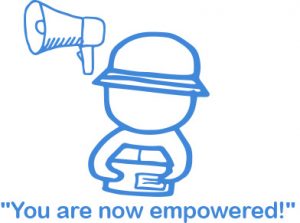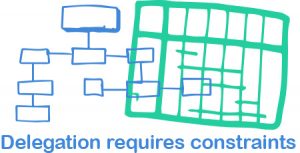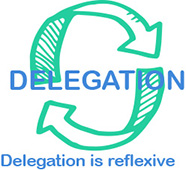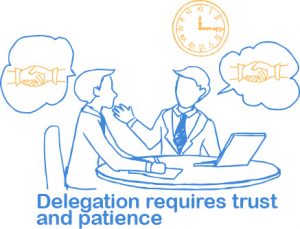Employee Empowerment demystified Part 1
Most organizations are aware that these times of high complexity and fast paced change are a challenge to cope with, especially for management. It’s not that traditional management techniques are wrong per se, but they are no longer the most appropriate way to face today’s complexity. So organizations are struggling to implement alternative ways of managing: Employee empowerment; servant leadership; decentralized decision making; delegation; self-organizing teams, these are all terms for the same concept: put the authority where the information is. The concept proofs to be pretty hard to implement however. This article is going to demystify empowerment and delegation as well as provide a simple yet powerful Management 3.0 tool that you can start using today.
The reason why empowerment is important is that it enables faster and better decision making. Today’s organizations operate in a complex environment. You cannot rely on following proven optimized processes because the work is not that predictable anymore. We often find ourselves doing things we haven’t done before. We need experts that can analyze complicated situations, and creative workers that know how to quickly create and validate ideas using experiments. These workers most often know the work better than their managers. So let them decide: decisions will be better because they know better. And they will be faster because the hierarchal chain of authority is short circuited.
Exploring principles of empowerment
 So let’s assume we have an old school command and control type of manager, called Sam. Don’t blame Sam by the way, because it’s organizations and the education system that create and maintain Sams. Sam participates in a new management program in his company with the purpose of turning managers into servant leaders. Sam gets the reason why. He is enthusiastic about the change, a little anxious perhaps, but his guts tell him this is a more effective way. So he is going for it.
So let’s assume we have an old school command and control type of manager, called Sam. Don’t blame Sam by the way, because it’s organizations and the education system that create and maintain Sams. Sam participates in a new management program in his company with the purpose of turning managers into servant leaders. Sam gets the reason why. He is enthusiastic about the change, a little anxious perhaps, but his guts tell him this is a more effective way. So he is going for it.
On Monday morning Sam gathers his team members telling them he is going to be a different manager. He will be facilitating and coaching the members from now on, and not be telling them what to do anymore. “I want you guys to be empowered”, he tells them. “You are a self-organizing team from now on”. While the team’s reaction was not as enthusiastic as he had expected, Sam is still confident and excited.
A few weeks go by and Sam is feeling increasingly frustrated. Things are not changing as fast as he had expected. He feels people could be more proactive. Why aren’t they taking initiative?! After all he has given them every room to do so. Why do they not seem to feel accountable for results? He has just told them what results he expects leaving the ‘how’ up to them, just as he was taught in the servant leadership workshop he attended. But it hasn’t led to better results yet. As a matter of fact, he was forced to step in a couple of times to correct mistakes that were made. He begins to feel that at least some team members cannot handle responsibility. Or maybe they just prefer to be controlled.
This is not an uncommon scenario. Agile coaches and Servant Leadership aficionados will tell you people want to have control over their own work. So why does it proof to be so cumbersome and slow to implement empowerment and delegation? Let’s unravel the principles of empowerment and delegation.
 The first principle seems to be contradicting at first: Empowerment cannot be successful without clear constraints. “Wait a minute, empowerment was about giving people more control. So what are you talking about when you say you need to set constraints?” Delegation is never absolute, so unless you are very transparent which decisions people can make themselves and which they cannot, they will be reluctant to make any decision. People will feel insecure on making a decision not sure if it is really ok. They might take a backseat waiting for others to go first. They might be conspicuous whether the company really means it and will not blame them for the very first mistake they make as a result of a decision. Although it might sound contradicting, if you set clear boundaries and are very transparent on them, you create a safe environment for taking initiative.
The first principle seems to be contradicting at first: Empowerment cannot be successful without clear constraints. “Wait a minute, empowerment was about giving people more control. So what are you talking about when you say you need to set constraints?” Delegation is never absolute, so unless you are very transparent which decisions people can make themselves and which they cannot, they will be reluctant to make any decision. People will feel insecure on making a decision not sure if it is really ok. They might take a backseat waiting for others to go first. They might be conspicuous whether the company really means it and will not blame them for the very first mistake they make as a result of a decision. Although it might sound contradicting, if you set clear boundaries and are very transparent on them, you create a safe environment for taking initiative.
 Empowerment is reflexive. Delegation is not a one way street. It goes both ways. Employees have expectations of what they can leave up to the manager too. A team might not feel comfortable with a certain level of delegation for some area (yet), even if you do. As a manager you need to respect that. Delegation does not only go downwards. It goes up too.
Empowerment is reflexive. Delegation is not a one way street. It goes both ways. Employees have expectations of what they can leave up to the manager too. A team might not feel comfortable with a certain level of delegation for some area (yet), even if you do. As a manager you need to respect that. Delegation does not only go downwards. It goes up too.
 Empowerment requires trust. And patience. When you say you are going to leave certain decisions to the employees, you better mean it. Don’t come rushing in with good advice the moment you see some hesitation. Trust them to get it sorted out. Even worse is blaming them for a mistake they are inevitably going to make. Instead of “What were you thinking?!” say “What can we do better next time?”. Your choice of words, no matter how subtle, is crucial. Your mental model might unconsciously lure you into choosing words that have a backwards effect. It will feel frustrating at times, it will test your patience, you will have to stop yourself from stepping in. Don’t get me wrong, I don’t mean just let them sink. You are there to help if they want it. But don’t take over. Trust goes both ways too: you need to trust the workers, but you need to live up to their trust as well. If you don’t the momentum is gone and they will not dare to take initiative anytime soon anymore.
Empowerment requires trust. And patience. When you say you are going to leave certain decisions to the employees, you better mean it. Don’t come rushing in with good advice the moment you see some hesitation. Trust them to get it sorted out. Even worse is blaming them for a mistake they are inevitably going to make. Instead of “What were you thinking?!” say “What can we do better next time?”. Your choice of words, no matter how subtle, is crucial. Your mental model might unconsciously lure you into choosing words that have a backwards effect. It will feel frustrating at times, it will test your patience, you will have to stop yourself from stepping in. Don’t get me wrong, I don’t mean just let them sink. You are there to help if they want it. But don’t take over. Trust goes both ways too: you need to trust the workers, but you need to live up to their trust as well. If you don’t the momentum is gone and they will not dare to take initiative anytime soon anymore.
Empowerment is an investment, it may take a while before you get your return on investment. Remember, people are wired for compliance. Not by nature, but by organizations and the education system. It starts as soon as children go to school: Suddenly you are required, both litterally and figurally speaking to color within the lines. Mistakes are structurally corrected. “Making a mistake is wrong” is the unconcious message. All day you are supposed to do what you are told. It gets even clearer when you start your first job. Others tell you what to do and how. All employee engagement programs set aside, people feel they are expected to comply. So when you are genuinely trying to change this in your organization, know it will take a while for people to change.
Understanding these principles is one thing, using them is another. In part 2 of this blog we provide a simple yet effective tool for delegation that honours the principles just discussed.
Do you want to learn more about modern management? Attend one of our Management 3.0: Modern Leadership Practices classes.




